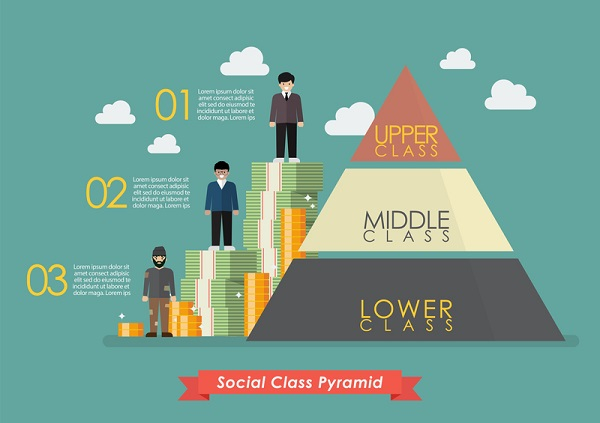

Social stratification refers to how society is divided into different layers or classes based on factors such as wealth, power, and prestige. It is a central concept in sociology and is closely related to issues of social inequality and social mobility. In this article, we will explore the various theories that have been developed to understand the nature and characteristics of social stratification and examine the key elements that make up the stratified structure of society.
It is a central concept in sociology and is closely related to issues of social inequality and social mobility. In this article, we will explore the various theories that have been developed to understand the nature and characteristics of social stratification and examine the key elements that make up the stratified structure of society.
Figure : Concept of Social Stratification
Social stratification refers to the hierarchical arrangement of individuals or groups based on their access to resources, power, and prestige.
Stratification is a universal feature of human societies, but the specific forms it takes and the meanings attached to it vary widely across different cultures and historical periods.
Stratification is typically based on characteristics such as class, race, ethnicity, gender, and age, which can be either ascribed (inherited) or achieved (earned).
Stratification can be either open or closed, depending on the degree of mobility and opportunity it allows for individuals to move between different strata.
Stratification is often justified based on merit, talent, or hard work, but it can also be based on discrimination, prejudice, or exploitation.
The functionalist theory sees social stratification as a necessary and beneficial component of society, as it serves to allocate resources, motivate individuals, and stabilise social order.
Conflict theory argues that social stratification results from power struggles and resource competition between different groups in society, and that it perpetuates inequality and social division.
Symbolic interactionist theory focuses on the meanings and symbols attached to social positions, and how these shape the interactions and identities of individuals within a stratified society.
Other theories of social stratification include exchange theory, which sees stratification as a result of the trade-offs and negotiations individuals make to maximise their rewards, and evolutionary theory, which sees stratification as a product of natural selection and adaptation to different environmental conditions.
Social stratification is typically characterised by three main dimensions: class, status, and power.
Class refers to the economic position of individuals or groups in terms of their ownership and control of resources, such as wealth, income, and property.
Status refers to the social position of individuals or groups, based on factors such as education, occupation, and lifestyle.
Power refers to the ability of individuals or groups to control and influence others, either through formal authority or informal means.
Stratification systems may also be based on other characteristics, such as race, ethnicity, gender, and age, which can intersect and overlap with class, status, and power in complex and varied ways.
Social stratification can be either vertical or horizontal, depending on the degree of inequality and the relationship between different strata.
Vertical stratification refers to a hierarchical arrangement of strata, with those at the top having more power, resources, and prestige than those at the bottom.
Horizontal stratification refers to a more equal distribution of resources and opportunities among different strata, with less clear hierarchy or differentiation between them.
Social stratification can be either open or closed, depending on the degree of mobility and opportunity it allows for individuals to move between different strata. Open stratification systems allow for greater mobility, while closed stratification systems are more rigid and restrict movement between strata.
Social stratification can also be either institutionalised or informal, depending on the degree to which it is formally recognized and supported by social norms and institutions. Institutionalized stratification is more structured and stable, while informal stratification is more fluid and subject to change.
Class is a common element of social stratification systems. It refers to the economic position of individuals or groups in terms of their ownership and control of resources such as wealth, income, and property.
Caste is a form of social stratification based on rigid and inherited social categories, which dictate an individual's occupation, marriage, and social interactions.
An estate is a form of social stratification based on inherited status, such as nobility or royalty, which confers special privileges and obligations to individuals.

Figure : Social Class Pyramid
In conclusion, social stratification refers to the hierarchical arrangement of individuals or groups based on their access to resources, power, and prestige. It is a complex and multifaceted concept, shaped by a variety of theories and perspectives, and characterised by dimensions such as class, status, and power. Social stratification has significant implications for the lives and opportunities of individuals and groups within a society and can be a source of both conflict and cooperation.
Q1. What is the main cause of social stratification?
Ans. The main cause of social stratification is debated among sociologists and other social scientists. Some argue that it is a natural and inevitable aspect of human societies, while others see it as the result of power struggles and resource competition between different groups.
Q2. Is social stratification always a negative thing?
Ans. Social stratification is not necessarily a negative thing, as it can serve to motivate individuals and allocate resources in ways that benefit society as a whole. However, it can also create inequalities and injustices that have negative consequences for individuals and groups
Q3. Can social stratification be eliminated?
Ans. Eliminating social stratification is likely impossible, as it is a universal feature of human societies. However, it is possible to reduce inequality and promote greater social mobility through policies and programs that address the root causes of social stratification.